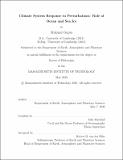Climate system response to perturbations : role of ocean and sea ice
Author(s)
Gupta, Mukund.
Download1191838816-MIT.pdf (35.14Mb)
Other Contributors
Massachusetts Institute of Technology. Department of Earth, Atmospheric, and Planetary Sciences.
Advisor
John Marshall.
Terms of use
Metadata
Show full item recordAbstract
When the Earth experiences a perturbation in its radiative budget, the global ocean can buffer climate change, while sea ice may amplify its effects via a positive albedo feedback. It is therefore of interest to consider the role of the ocean in the climate's response to changes in external forcing, such as volcanic eruptions, Snowball Earth initiation and rearrangements of the carbon cycle. The first part of this thesis isolates the impact of the deep ocean in the surface response to volcanic cooling. Relaxation of the surface temperature follows a two-timescale decay, due to ocean heat exchange being significantly stronger than climatic feedbacks. Deep ocean cooling sequestration helps explain long periods of cold climate that occurred, for example, during the Little Ice Age. The second part explores the volcanic forcing required to initiate state transitions in a GCM with multiple climate equilibria. Snowball transitions require cooling on the order of -100Wm⁻² for several decades. These transition timescales are a consequence of the whole water column needing to be cooled to the freezing point before sea ice develops at the surface. The third part investigates biogeochemical interactions between oceans and sea ice around Antarctica. During the glacial cycles of the Pleistocene, sea ice may have helped trap carbon in the ocean by inhibiting CO₂ outgassing. This work shows that flux capping may be weakened by the effect of sea ice on reducing the light available for biological productivity. Consequently, a large sea ice fraction is required to effectively cap the flux of carbon to the atmosphere.
Description
Thesis: Ph. D., Massachusetts Institute of Technology, Department of Earth, Atmospheric, and Planetary Sciences, May, 2020 Cataloged from the official PDF of thesis. Includes bibliographical references (pages 169-187).
Date issued
2020Department
Massachusetts Institute of Technology. Department of Earth, Atmospheric, and Planetary SciencesPublisher
Massachusetts Institute of Technology
Keywords
Earth, Atmospheric, and Planetary Sciences.